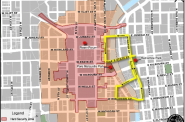Mayor Johnson Introduces First Budget
Budget raises fees, taxes, cuts police, library hours as a result of 'broken' state funding system.
Mayor Cavalier Johnson will introduce his first executive budget proposal Tuesday morning.
It’s a tough assignment. Milwaukee faces a substantial fiscal cliff that threatens to decimate city services and trigger more than 1,000 layoffs.
The proposed budget maintains a “calm before the storm” approach that Mayor Tom Barrett used in his final years, though Johnson has placed substantial focus on finding a long-term solution with the Wisconsin Legislature.
Federal aid is buying two years of calm, with planned injections of approximately $80 million annually from the city’s remaining American Rescue Plan Act funding. But even with that, Johnson’s 2023 budget will raise fees, eliminate 17 police officer positions (1% of the authorized force), mothball two fire engines and cut library hours among other changes.
A confluence of factors including rising pension costs, state restrictions on raising revenue and decreasing state aid are pushing the city towards the cliff. And without state intervention, the cliff will be painful. A 2021 report by the city budget office warned that one in four city workers could be laid off.
“This is not an issue that’s unique to the City of Milwaukee,” said the mayor. “Brookfield, one of the most wealthy communities in the state, they too are approaching a problem point in the next few years where they won’t be able to pay their bills. And if the state’s system for funding local governments does not work for a community that is as wealthy and as well resourced as Brookfield, then it simply doesn’t work.”
The mayor said that in his conversations with Republican leaders there is an understanding of the “dire situation” and that he thinks the city has a better relationship with the state than any time in the past 15 years. “Their system is broken for funding local governments, ” said Johnson. “Out of service for their own constituency, they will have to fix the issue.”
“In the big picture, why is there a hole? The number one factor is shared revenue,” said budget director Nik Kovac. He said, adjusted for inflation, the city now receives $155 million less annually from the state than it did in 2000. That amount is virtually equivalent to what the city’s structural deficit is expected to be in 2025 when the ARPA grant runs out and the city needs to make substantially increased contributions to keep its pension system fully funded.
Taxes and fees for the median single-family homeowner are expected to increase by approximately $48.60 under Johnson’s budget. That includes a 4% increase in fees for water and other city services.
The actual city property tax rate (mill rate) is expected to fall by almost 10% from $10.16 per $1,000 in assessed value to $9.16. The figure is calculated by the cumulative assessed value of all properties in the city, which increased by 13% in the past year. As a result of new construction and a small state-allowed increase in property tax revenue, the city expects to collect 2% more in property tax revenue in 2023. But adjusted for inflation, the actual property tax levy will have fallen by $6.3 million annually since 2013.
Changes to Police, Libraries
Johnson’s 2023 budget would cut the “sworn strength” of the police department through retirements, but it would not cut the actual budget for the department. Kovac said that is due to a new agreement with the labor unions that makes individual officers cost more in salary and benefits. He said the department is being asked to make additional cuts to things like custodial services. The size of the police cut could grow if the city is not awarded a federal COPS grant later this year.
“If I had more money, I would invest more in police,” said Johnson. “But the fact of the matter is the system for funding local governments I don’t have the money to do that.” Police and fire personnel are the only city workers still protected by collective bargaining after the 2011 Act 10 state law change.
Kovac said police, fire and library services are the most straightforward to cut because they are not primarily funded by grants or fees.
Milwaukee Public Library leaders drew praise from Johnson for being forward thinking. Under the mayor’s proposal, it will reduce staffing and hours at four locations and temporarily close the Martin Luther King Library while a replacement is built. But some of the savings will go into three targeted libraries where staffing increases will allow outreach into the community beyond the physical libraries. “We are really grateful for them for doing that,” said Johnson.
Pay Raise for City Workers
The budget would include a 2% raise for all general city employees (non-police and fire workers) and an additional, one-time 1% raise for employees who have been with the city at least five years.
“When it comes to this. It’s one of those things that you can’t afford to do it, because of the challenges that you face, but you also can’t afford not to do it because if you don’t address it you’re going to have people continue to go out the door,” said Johnson of the raises. “We think this is a way to stop the people that are leaving, but also to bring people in.”
Departments have routinely briefed the council on turnover issues in recent years. Kovac said the vacancies would lead you to believe there are substantial budget savings, but it’s more expensive to pay the remaining employees overtime or hire contractors to perform the work.
One thing Johnson’s proposal doesn’t touch is approximately $80 million in a pension reserve fund. Kovac said that money, steadily increased by Barrett and Johnson (as council president) in anticipation of the cliff, would be best spread out over the five-year pension funding increase instead of used to delay the cliff by another year.
Wisconsin Policy Forum Analysis
The city’s pension system is 83.4% funded, an amount that exceeds many other public funds says a new Wisconsin Policy Forum (WPF) report. But it needs to be 100% funded based on a series of regulations that govern its operation. Next spring, the city will receive a new annual contribution requirement from the system as part of a five-year smoothing formula. That amount is expected to increase the annual contribution between $50 million and $70 million, with police and fire costs driving most of the increase. (That’s where their exemption from Act 10 and its reduction in public employee benefit costs has an impact.) WPF’s report notes that police and fire employees account for 80% of the cost, but only 43% of the city’s workforce.
“Our warning, therefore, is that city and state leaders must begin to talk and act almost immediately if they wish to avoid untenable budget cuts,” concludes the report.
Kovac, then a council member, served on a 2021 workgroup that examined 12 options to address the pension-related fiscal issues, including adopting a sales tax, moving to the state pension system or restricting benefits.
Look for more detailed budget breakdowns in the coming weeks from Urban Milwaukee as documents become available and the council begins its amendment process.
If you think stories like this are important, become a member of Urban Milwaukee and help support real, independent journalism. Plus you get some cool added benefits.
More about the 2023 Milwaukee Budget
- City Hall: Council Overrides Mayor Johnson’s First Vetoes - Jeramey Jannene - Nov 22nd, 2022
- Mayoral budget vetoes to be taken up at Common Council meeting on November 22 - Common Council President Jose Perez - Nov 11th, 2022
- Mayor Vetoes Library, Fire Service Cut Restorations in 2023 Milwaukee Budget - Jeramey Jannene - Nov 11th, 2022
- Mayor’s Office Adds ‘Vision Zero’ Czar - Jeramey Jannene - Nov 8th, 2022
- Milwaukee Building New Cruise Ship Dock - Jeramey Jannene - Nov 7th, 2022
- Council Reverses Cuts, Raises Fees In Adopting 2023 Milwaukee Budget - Jeramey Jannene - Nov 4th, 2022
- City Hall: Council Beefing Up Negotiation Team In Advance of Public Safety Contract Talks - Jeramey Jannene - Oct 28th, 2022
- City Hall: Mayor, Council At Odds Over How To Prepare For Fiscal Cliff - Jeramey Jannene - Oct 27th, 2022
- City Hall: Proposed Budget Amendments Reverse Library, Fire Department Cuts - Jeramey Jannene - Oct 24th, 2022
- City Hall: Library Poised To Cut Services At 5 Branches In 2023 - Jeramey Jannene - Oct 14th, 2022
Read more about 2023 Milwaukee Budget here
More about the Local Government Fiscal Crisis
- Mayor Johnson’s Budget Hikes Fees, Taxes In 2025, Maintains Services - Jeramey Jannene - Sep 24th, 2024
- New Milwaukee Sales Tax Collections Slow, But Comptroller Isn’t Panicking - Jeramey Jannene - Jun 28th, 2024
- Milwaukee’s Credit Rating Upgraded To A+ - Jeramey Jannene - May 13th, 2024
- City Hall: Sales Tax Helps Fire Department Add Paramedics, Fire Engine - Jeramey Jannene - Jan 8th, 2024
- New Study Analyzes Ways City, County Could Share Services, Save Money - Jeramey Jannene - Nov 17th, 2023
- New Third-Party Study Suggests How Milwaukee Could Save Millions - Jeramey Jannene - Nov 17th, 2023
- Murphy’s Law: How David Crowley Led on Sales Tax - Bruce Murphy - Aug 23rd, 2023
- MKE County: Supervisors Engage in the Great Sales Tax Debate - Graham Kilmer - Jul 28th, 2023
- MKE County: County Board Approves Sales Tax - Graham Kilmer - Jul 27th, 2023
- County Executive David Crowley Celebrates County Board Vote to Secure Fiscal Future and Preserve Critical Services for Most Vulnerable Residents - County Executive David Crowley - Jul 27th, 2023
Read more about Local Government Fiscal Crisis here
Political Contributions Tracker
Displaying political contributions between people mentioned in this story. Learn more.
- May 7, 2015 - Nik Kovac received $10 from Cavalier Johnson
























